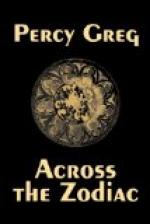At each side of the larger chambers and of the engine-room were fixed small thick circular windows, through which we could see from time to time the more remarkable objects in the water. We passed along one curious submarine bank, built somewhat like our coral rocks, not by insects, however, but by shellfish, which, fixing themselves as soon as hatched on the shells below or around them, extended slowly upward and sideways. As each of these creatures perished, the shell, about half the size of an oyster, was filled with the same sort of material as that of which its hexagonic walls were originally formed, drawn in by the surrounding and still living neighbours; and thus, in the course of centuries, were constructed solid reefs of enormous extent. One of these had run right across the gulf, forming a complete bridge, ceasing, however, within some five feet of the surface; but on this a regular roadway had been constructed by human art and mechanical labour, while underneath, at the usual depth of thirty feet, several tunnels had been pierced, each large enough to admit the passage of a single vessel of the largest size. At every fourth hour our vessel rose to the surface to renew her atmosphere, which was thus kept purer than that of an ordinary Atlantic packet between decks, while the temperature was maintained at an agreeable point by the warmth diffused from the electric machinery.
On the sixth day of our voyage, we reached a point where the Gulf of Serocasfe divides, a sharp jutting cape or peninsula parting its waters. We took the northern branch, about fifteen miles in width, and here, rising to the surface and steering a zigzag course from coast to coast, I was enabled to see something of the character of this most extraordinary strait. Its walls at first were no less than 2000 feet in height, so that at all times we were in sight, so to speak, of land. A road had been cut along the sea-level, and here and there tunnels ascending through the rock rendered this accessible from the plateau above. The strata, as upon Earth, were of various character, none of them very thick, seldom reproducing exactly the geology of our own planet, but seldom very widely deviating in character from the rocks with which we are acquainted. The lowest were evidently of the same hard, fused, compressed character as those which our terminology calls plutonic. Above these were masses which, bike the carboniferous strata of Earth, recalled the previous existence of a richer but less highly organised form of vegetation




